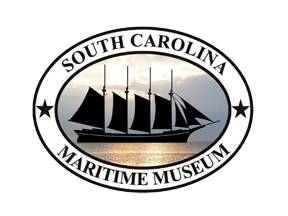Our first exhibit: Lumber Schooners

Georgetown, SC – January 30, 2012- The South Carolina Maritime Museum will present its first temporary exhibit: a photographic display of lumber schooners that visited the port of Georgetown at the beginning of the twentieth century. The exhibit will open with a reception on Thursday, February 9, 2012 from 5pm until 7pm.
The Museum opened its doors in December of last year. This first exhibit tells the story of the lumber schooners that sailed in and out of Georgetown between 1890 and 1920 when Georgetown was the biggest lumber port in the Southeast. Sailing ships and steamships transported millions of feet of pine and cypress lumber from South Carolina forests to cities in the northeastern United States. The stories of these ships and their crews are an important part of the maritime history of South Carolina.
The new Lumber Schooners exhibit is a series of 26 enlarged photographs, charts, and maps that have been reproduced, courtesy of the Maine Maritime Museum and the Georgetown County Digital Library. Much of the exhibit is devoted to the City of Georgetown, a four-masted sailing schooner chartered by the Atlantic Coast Lumber Company, whose mill in Georgetown was one of the largest lumber operations in America at the time. The construction of the vessel was financed by a group of forty nine investors, nine of whom were Georgetown people.
The black-and-white and sepia photo enlargements in the exhibit depict the life story of the City of Georgetown. The 168 foot vessel was built at the William Rogers Shipyard in Bath, Maine. She had a short, but busy, life. Her maiden voyage was to Georgetown in 1902. Eleven years later, in 1913, after many voyages delivering lumber to New England shipyards, she was rammed and sunk off the Atlantic coast by the German ocean liner Prinz Oskar, though all hands were saved
Other exhibits of South Carolina maritime history will follow. It is the purpose of the South Carolina Maritime Museum to offer a variety of experiences to young people and adults by collecting, preserving and interpreting items of historical interest for educational purposes and to recount South Carolina maritime history through artifacts, documents and other materials of antique or historical value. The exhibits will further the public interest, knowledge, understanding, and appreciation of the seagoing heritage of South Carolina.
